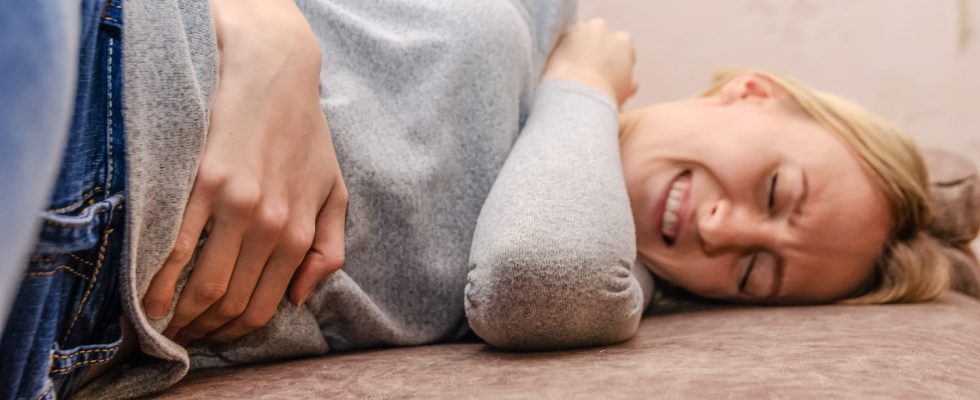A convulsion is a violent and involuntary contraction of several muscles or even the whole body. This symptom can occur as a crisis in adults or children. What are the causes ? What to do ?
Seizures feel like spasms. These are contractions or violent and involuntary stiffness several muscles, sometimes even the whole body. A convulsion usually lasts 1 to 2 minutes, but may last only a few seconds. What are the signs a seizure? What is the cause a seizure? Is it serious to convulse? How to react ?
What are seizures?
Seizures are involuntary and violent contractions (similar to spasms) of the muscles of the body, associated with a loss of consciousness: we then speak of generalized epileptic seizure.
What is the difference between a seizure and an epileptic seizure?
“We speak of an epileptic seizure when a group of neurons (a kind of brain cells) start to malfunction synchronously. This neuron group can be more or extended“, explains Dr. Muriel Laffon, epileptologist neurologist in Nice 5% of the population will have at least one epileptic seizure in their lifetime. Just because you have an epileptic fit doesn’t mean you have epilepsy.. Epilepsy is a disease characterized by the repetition of epileptic seizures spontaneously. 500 to 600,000 patients have epilepsy in France.
What causes a seizure?
The origin of convulsions is varied:
► The convulsion can be the cause of a brain attack. For example :
- Fever may cause hyperthermic convulsions in infants
- Phenomena of hyper and hypoglycemia as in diabetics
- Dehydration
- An ion imbalance (salt, magnesium, calcium, etc.)
- An infectious brain disease (meningitis, encephalitis)
- A sickness vascular (cerebrovascular accident by artery occlusion or intracerebral hemorrhage
► Excessive alcohol consumption or stopping it in a chronic drinker
► Taking certain treatments or some drugs
► One lack of sleep
► A strong stress
What are the symptoms of a tonic-clonic seizure?
It is one of the generalized epilepsies of the brain. The firing of the neurons is immediately propagated to the two cerebral hemispheres. The patient presents with a loss of consciousness followed by bilateral and symmetrical motor manifestations. There is a tonic phase (intense muscle contraction), then clonic (symmetrical rhythmic jerks), at the end of the crisis the patient presents a stertor noisy breathing. During the crisis, the patient may bite his tongue on the side or lose urine. The patient regains consciousness several minutes later, he is often confused (lost) at first and gradually consciousness returns. He will have no memory of the episode.
According to Dr. Laffon “in some cases there may be photosensitivity. The patient is then embarrassed in a nightclub (strobes), in the car if the plane trees pass by the side of the road, or in front of certain video games/cartoons. These visual stimuli can cause a seizure to occur in a known epileptic patient.“Photosensitivity remains rare and is screened by the neurologist.
What are the signs of absence epilepsy?
Absences are also part of generalized epilepsies. The patient presents a very fleeting suspension of consciousness (like a blank). According to neurologist Muriel Laffon “Absence epilepsy is a disease that can affect children from 5 or 6 years old. Usually there are a hundred attacks per day (blanks of about ten seconds maximum). We often take the child for someone inattentive.“This type of epilepsy can also occur in adolescents, in whom seizures are less frequent. In adolescents, these absence seizures can be associated with generalized seizures.
What are the signs of a focal seizure?
Focal seizures start in one part of the brain. “The first symptoms are related to the dysfunctional area of the brain. For example, if the seizure begins in the lobe of vision, the patient will experience abnormal visual symptoms (vision of light flash, distortion of the image). In this case, there are not always visible external symptoms“, explains neurologist Muriel Laffon “Any stereotypical, brief manifestations (from a few seconds to a few minutes) experienced by a patient may correspond to undiagnosed focal seizures.
What to do in case of convulsion or crisis?
► Go to the doctor or the emergency room. In the event of the first attack of convulsions, it is necessary always go to the emergency room or see a doctor very quickly. In the event of a seizure in a known epileptic, the neurologist should be contacted without urgency.
► Protect the patient. “The attitude to adopt in the event of occurrence of a generalized tonic-clonic seizure is the same regardless of age..” explains the neurologist on the one hand, the patient must be protected (restrain him in the event of a fall, remove any object that could injure him). You have to time it, a crisis must give way spontaneously after 3 to 4 min maximum. If it lasts more than 5 minutes, it is imperative to call 15. The attack is often impressive for relatives and the time seems to increase tenfold”. In some cases, in patients known to often have long attacks, we can sometimes administer a direct treatment at home by relatives, the protocol varying according to the case.
► It is also important to clear the airways by loosening a shirt collar for example. On the other hand, it is useless to try to restrain or control the patient at the risk of injuring him. The specialist also specifies that contrary to popular belief “It is important not to try to put anything in your mouth. The idea that there is a risk of swallowing your tongue is false“
► The patient can be placed in the lateral safety position (PLS)only when the tonic-clonic phase is over, i.e. when the tremors have stopped.
Thanks to Dr Muriel Laffon, epileptologist neurologist in Nice.
